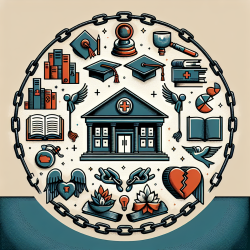Understanding Medical Care Utilization in Disadvantaged Populations
In the realm of speech-language pathology and online therapy services, understanding the broader context of healthcare utilization can significantly enhance the quality of care provided to children and other vulnerable groups. A recent study titled Utilization of Primary and Secondary Medical Care among Disadvantaged Populations: A Log-Linear Model Analysis sheds light on how socio-economic status (SES), age, and geographic location influence medical care utilization among disadvantaged populations. This research offers insights that can inform practitioners about potential inequalities in healthcare access and utilization.
Key Findings and Implications
The study conducted by Din, Zugman, and Khashper (2014) analyzed data from the 2009 Israeli National Health Survey using log-linear models. The results revealed several critical findings:
- Pro-poor Utilization of Primary Medical Care: Elderly populations in peripheral areas with low SES had higher odds of utilizing primary medical care compared to those with higher SES.
- Pro-rich Utilization of Secondary Medical Care: Younger populations who did not regularly visit general practitioners (GPs) showed a tendency towards pro-rich utilization of secondary medical care.
- Interaction Effects: The study highlighted the lack of interaction between SES and primary medical care utilization among younger populations, and between SES and secondary medical care utilization among the elderly.
Practical Applications for Practitioners
For practitioners, these findings underscore the importance of tailoring healthcare strategies to address the unique needs of disadvantaged populations. Here are some actionable insights:
- Enhance Accessibility: Focus on improving access to primary care services for elderly populations in peripheral regions. This could involve leveraging online therapy platforms to reach those with limited mobility or transportation options.
- Targeted Interventions for Younger Populations: Educate younger populations about the importance of regular GP visits and preventive care to mitigate pro-rich utilization trends in secondary care.
- Data-Driven Decision Making: Utilize data analytics to identify patterns in healthcare utilization and develop targeted interventions that address the specific needs of different demographic groups.
Encouraging Further Research
While the study provides valuable insights, it also opens avenues for further research. Practitioners are encouraged to explore the following areas:
- Investigate the impact of cultural and educational differences on healthcare utilization among disadvantaged populations.
- Examine the role of telehealth and online therapy services in improving healthcare access and outcomes for remote or underserved communities.
- Conduct longitudinal studies to assess the long-term effects of healthcare utilization patterns on health outcomes.
By integrating these insights into practice, practitioners can contribute to reducing healthcare disparities and enhancing the quality of care for disadvantaged populations. For a deeper understanding of the research findings, you can access the original research paper here.










